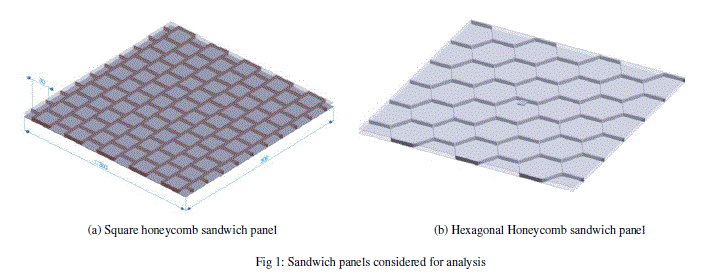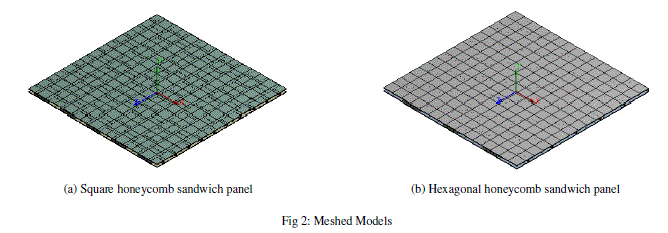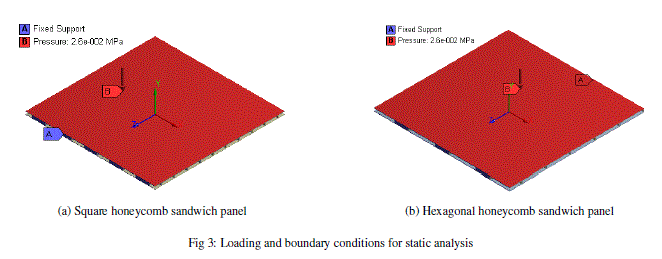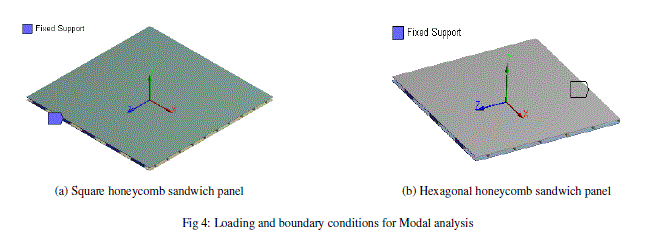ISSN ONLINE(2319-8753)PRINT(2347-6710)
ISSN ONLINE(2319-8753)PRINT(2347-6710)
Ch. Naresh1, A. Gopi Chand2, K. Sunil Ratna Kumar3, P.S.B.Chowdary4
|
| Related article at Pubmed, Scholar Google |
Visit for more related articles at International Journal of Innovative Research in Science, Engineering and Technology
Low weight and high strength panels is always a design consideration. Sandwich panel technology offers an efficient solution for this problem. Different types of sandwich panels are currently being used depending on the applications. Honeycomb sandwich panels are a better solution in structural design problem. Different honeycomb cores are currently being used. In the current work, a comparison of response of Square and Hexagonal honeycomb sandwich panels is made. Numerical simulations using FE techniques are used for simulating the behavior of the sandwich panels under uniformly distributed loads. During simulation, two different combinations of materials (face material – core material) are considered. Based on the response, it is found that though Al-Al sandwich panel with square honeycomb structure, though has lower stress values, showed greater deflection than SS-Cu panel. Modal analysis is also executed to extract the natural frequencies. It is found that square honeycomb panel has higher natural frequencies than that of hexagonal honeycomb panel.
Keywords |
| Square honeycomb, hexagonal honeycomb, Sandwich Panels, Uniformly Distributed Load |
INTRODUCTION |
| Sandwich panels are finding applications in many areas, namely thermal and structural areas. In structural applications, honeycomb panels are finding increasing applications. Any sandwich panel consists of two facing sheets with a core sandwiched between them. Core material is generally a softer material compared to facing sheet materials. Economic core technologies [14] in their product brochure gave the advantage of using light weight sandwich panels made of wooden face sheets and PP honeycomb core. The main advantage is to reduce the CO2 foot print. Davide Caprioli [8] discussed the application of honeycomb sandwich structures in automobile industry. A mathematical model based on a multi-scale asymptotic technique is proposed in the work. D N Cross [13] listed the applications of honeycomb sandwich panels. Theoretical formulations of hexagonal honeycomb structures is presented in this report. M M Islam, et al [6] developed composite panels with GFRP facing and phenolic core for structural applications. Failure mechanisms of the panel are experimentally investigated when the panel is supported either at two or four edges and subjected to point/uniformly distributed loading. In all the cases, it was observed that the behavior of the panels is the same. M K Khan [11] performed experimentation to find the sandwich panel with higher stiffness and lamination strength between GFRP and Al faced honeycomb sandwich panels for space craft applications. Flat and Edge wise compressive experiments are performed on the panels during this research. The strain energy and the critical stress were calculated in one of the compression mode. Different ASTM standards for testing honeycomb sandwich panels were used during the process. Vipin Jain, et al [12] compared the mechanical behavior of the Cordierite-mullite honeycomb with that of commercial ceramic foam with and without rubber encapsulation. Impact performance was studied for this purpose. Failure mechanisms for the different types of configurations with and without rubber encapsulation are also proposed in their work. K Kantha Rao, et al [5] theoretically evaluated the deflections and bending stresses of hexagonal honeycomb panels subjected to 3 point bending. Based on the results, it is found that the honeycomb core sheet thickness has greater effect on strength than that of the core height. Most of the work that was done in simulating the behavior of honeycomb sandwich panels is related to 3 – point bending or of simulating dynamic behavior. The current work consists of two parts of which first part consists of evaluating the behavior of honeycomb sandwich panel subjected to uniformly distributed load. Amit Kumar, et al [1] experimentally investigated the effect of stiffening the syntactic foam core by resin impregnated paper honeycomb (RIPH) structure on vibration characteristics of sandwich composite panels are under freely suspended configuration. Ganesh J G, et al [2] performed numerical simulations to evaluate the behavior of hexagonal honeycomb panels of different core and face sheet material combinations. During their investigations it was found that the response of sandwich panel with GFRP as core material and SS as face sheet material gave a better response. Dimitrios Garinis, et al [3] performed modal analysis on helicopter blade. The blade consisted of honeycomb core, 3D unidirectional composite spar and thin carbon composite face sheets as blade skin. Different approaches for numerical formulation were discussed. Strain energy plots for various mode shapes presented. Sourabha S. Havaldar [4] investigated experimentally into the effect of cell size on the natural frequencies of FRP honeycomb sandwich structure for various boundary conditions (cantilever, opposite sides fixed and all sides fixed). Numerical investigations were carried out for investigation of the same by modeling the structure as a plain sheet with equivalent orthotropic material model. Stijn Debruyne, et al [7] investigated experimentally the effect of various design parameters on dynamic behavior of Mopan honeycomb sandwich panels. Cell shape is considered to be circular. FE Simulations are executed to study the same numerically. Natural frequency and mode shape determination, response to local impact loading studied. Shigemasa Ando, et al [10] used extrapolation technique to the prediction of acoustically induced random vibration of honeycomb panel. Advantage of the extrapolation technique over SEA detailed. Extrapolation technique can predict the response based on the old experimental data acquired in the past and can give the result expeditiously. In all the above work, modal analysis is performed mostly on hexagonal honeycomb sandwich panel. The second section of the work investigates the effect of cell shape, core and face sheet material combination, on the natural frequency of the panel. The next section details the geometry of the panel. |
PROBLEM DEFINITION |
| As mentioned in the previous section, the aim of the current work is to evaluate the effect of two parameters, namely cell shape, core and face sheet material combination on the mechanical behavior of honeycomb sandwich panels. The geometry considered for investigation is shown in figure 1. It may be noted that the cell size as well as the panel size are maintained the same in both the cases. Two face sheet and core combinations are considered. These are tabulated in table 1. |
 |
MESHING & BOUNDARY CONDITIONS |
| The honeycomb panel model is imported into Ansys workbench. Both the models are meshed with solid elements after assigning the corresponding materials. Figure 2 (a) & (b) show the meshed models of the sandwich panels. In the first section of the work, response of each panel to uniformly distributed load is predicted using static analysis. For this simulation, two edges of the sandwich panel are fixed and uniformly distributed load of 0.026MPa is applied on one face. Figure 3 shows the loading and boundary conditions for the static analysis. In the second section modal analysis is executed on each panel to predict the natural frequencies of the panels between 10Hz to 10000Hz. Figure 4 shows the boundary conditions for modal analysis. |
 |
RESULTS AND DISCUSSIONS |
| As mentioned earlier, static analysis with the panels subjected uniformly distributed load of 0.026MPa are executed on models of the four panels. Figures 5 & 6 are the graphs comparing the max deformations and equivalent stresses in each case. |
 |
| Based on the plots, it can be seen that lager stress are produced in hexagonal honeycomb sandwich panels with higher stresses (88.912Mpa) being in panels of Al-Al material. There is not much difference in the stresses induced in square honeycomb sandwich panels with either SS-Cu or Al-Al combination. On the other hand, larger deflections are produced in Al-Al honeycomb sandwich panels with max in Al-Al hexagonal honeycomb sandwich panel (0.74125mm). Minimum deflection is seen in SS-Cu panel with Square Honeycomb core. Figure 7 (a) and (b) shows the deformation and stress plots of SS-Cu Square Honeycomb sandwich panel. Based on these results, it can be concluded that SS-Cu Square Honeycomb Structure has better response when compared to other configurations. |
| Modal analysis is performed to study the natural frequencies of the honeycomb panels considered. Figure 8 shows the comparative plot giving natural frequencies for all the configuration. Based on the plots, it can be seen that Al-Al Square Honeycomb Sandwich Panels have higher natural. Figure 9 gives the first four mode shapes for SS-Cu honeycomb structure. |
 |
CONCLUSION |
| Static and Modal analysis executed to study the response of Square and Hexagonal honeycomb sandwich panels for various material combinations. Static analysis was performed with two edges of the panel fixed and subjected to a pressure load of 0.026MPa. Based on the results it is found that SS-Cu sandwich panel with square honeycomb core performs better. Modal analysis is then performed to extract the natural frequencies. Based on the analysis results, it is found that Al-Al Square honeycomb sandwich panel has higher natural frequencies compared to other configurations. |
References |
|